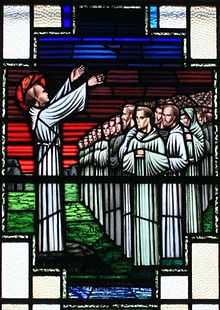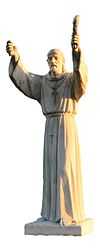Finnian of Clonard
| Finnian of Clonard | |
|---|---|
|
Statue of St. Finnian in Clonard | |
| Teacher of the Saints of Ireland | |
| Born |
470 Myshall, County Carlow |
| Died | 12 December 549 |
| Venerated in | Orthodox Church, including True Orthodox Church jurisdictions such as the Tikhonites, Roman Catholic Church |
| Major shrine | Clonard Abbey (destroyed) |
| Feast | 12 December |
| Patronage | Diocese of Meath |
Saint Finnian of Clonard ('Cluain Eraird') – also Finian, Fionán or Fionnán in Irish; or Vennianus and Vinniaus in its Latinised form (470–549) – was one of the early Irish monastic saints, who founded Clonard Abbey in modern-day County Meath. The Twelve Apostles of Ireland studied under him. Saint Finnian of Clonard (along with Saint Enda of Aran) is considered one of the fathers of Irish monasticism.[1]
Early life
Finnian was born at Myshall, County Carlow towards the end of the fifth century and it is said that all the birds of Ireland gathered as a portent of the holy life he would lead. His father was Rudraigh, an Ulster noble; his mother, Telach of Leinster.[2] His birthplace is generally supposed to have been near the present town of New Ross. Saint Abban baptised Finnian, and at an early age he was placed under the care of Bishop Fortchern of Trim.[3]
This introduction to the Christian Church awakens in him a hunger for more learning that drives him across the sea to Britain, and then further afield to France. St. Martin's famous monastery at Tours is his first point of landing, and his experiences there shape his idea of religious life. Tours is noted for its austerity, and for its sacrifice of physical comfort for spiritual gain. Finnian finds himself at home in this environment, and begins a lifetime of austere monastic discipline. After a time of study at Tours, Finnian was directed by St. Fortchern to proceed to Wales to perfect himself in holiness and sacred knowledge under the great saints of that country. Here, Finnian continued his studies at the monastery of Cadoc the Wise, at Llancarfan in Glamorganshire. He remains there for years, at prayer and study, growing in strength of spirit.[4] Finian made copies of Rome's classics and of St. Jerome's vulgate Bible.
Foundations

After a long sojourn in Wales, of thirty years according to the Codex Salmanticensis, a book of Irish Saints' lives, he returned to his native land and went about from place to place, preaching, teaching, and founding churches, most noticeably at Skellig Michael or Great Skellig eight miles off the coast of County Kerry, Ireland, which is a UNESCO World Heritage Site. His first monastery was at Aghowle, County Wicklow.
He came first to Aghowle in County Wicklow at the foot of Sliabh Condala, where Oengus, the king of Leinster, has no hesitation in granting him a site there. Here Finnian resided for sixteen years before travelling north to Dunmanogue on the river Barrow, where he establishes another church. From there, he goes to the town of Kildare, to study and teach at St Brigid's monastery. He is held in high regard by Brigid, but he is still not settled where God wants him to be. Around 520, he was at last led by an angel to Cluain Eraird (Clonard, County Meath) on the River Boyne, which he was told would be the place of his resurrection. Brigid presents him with a gold ring on his departure.[4]
At Clonard Finnian built a little cell and a church of clay and wattle, which after some time gave way to a substantial stone structure, and entered on a life of study, mortification, and prayer. The fame of his learning and sanctity was soon noised abroad, and scholars of all ages flocked from every side to his monastic retreat—young laymen and clerics, abbots, and bishops.[5] The Penitential of Finnian prescribes penances for sins with a view to correcting sinful tendencies and cultivating the contrary virtue. The document shows wide learning and draws on the teaching of St John Cassian on overcoming the eight evil tendencies – gluttony, fornication, covetousness, anger, dejection, accidie (laziness), vainglory and pride (The Institutes, Books 5–12).[6]
Later life and death
In the Office of St. Finnian it is stated that there were no fewer than 3,000 pupils getting instruction at one time in the school in the green fields of Clonard.[7] The master excelled in exposition of the Sacred Scriptures, and to this fact must be mainly attributed the extraordinary popularity which his lectures enjoyed. His gift for teaching and his absolute dedication to the ascetic ideal, inspired a whole generation. Ciaran of Clonmacnoise and Columcille of Iona are among the many to have trained under him.[4] They and many others took seeds of knowledge from Finnian's monastery at Clonard, and planted them abroad with great success. Clonard drew students from various parts of Europe. Finian died of the plague around 552.[8] His burial-place is in his own church of Clonard.
Finnian's sister, St. Regnach, was Abbess of Kilreynagh, near the present town of Banagher.
Veneration
Clonard became an important school because of the number of its students who went on to found other monasteries. For centuries after his death the school continued to be renowned as a seat of Scriptural learning, but it suffered at the hands of the Danes, especially in the eleventh century, and two Irishmen, O'Rorke of Breifney and Dermod McMurrough, helped to complete the work which the Northmen had begun.[5] The relics of Finnian himself were enshrined at Clonard until 887, after which the shrine was destroyed.[7] With the transference by the Norman Bishop of Rochfort, in 1206, of the See of Meath from Clonard to Trim, the glory of the former place departed forever.
St Finnian of Clonard's feast-day is 12 December,[3] which is first attested to in a Spanish Martyrology of the 9th century. In later years the monastery of Clonard came under the rule of the Uí Néill, and came to share an abbot with either Kildare or Clonmacnoise.[7]
Patronage
Finnian is the patron saint of the Diocese of Meath.[9]
Notes
- ↑ Wallace, Martin. A Little Book of Celtic Saints. Belfast. Appletree Press, 1995, ISBN 0-86281-456-1, p.19
- ↑ "St.Finnian", Monastic Ireland, retrieved 3 October 2011.
- ↑ 3.0 3.1 Thunder, John., "St. Finnian of Clonard", Irish Ecclesiastical Record, Vol. XIII, p. 810, 1892
- ↑ 4.0 4.1 4.2 "St. Finian of Clonard", All Saints Parish
- ↑ 5.0 5.1 Healy, John. "School of Clonard." The Catholic Encyclopedia. Vol. 4. New York: Robert Appleton Company, 1908. 19 Mar. 2013
- ↑ Duffy, Patrick. "St Finnian, abbot of Clonard", Catholic Ireland News, December 12, 2012
- ↑ 7.0 7.1 7.2 Farmer, David Hugh (1997). The Oxford dictionary of saints (4. ed. ed.). Oxford [u.a.]: Oxford Univ. Press. ISBN 0-19-280058-2.
- ↑ "Finian", Clonard College
- ↑ "Feast of St Finian, Patron of Meath Diocese", Diocese of Meath
References
- MacKillop, Charles James (1998), A Dictionary of Celtic Mythology, Oxford.
Further reading
Secondary sources
- Hughes, Kathleen. "The Cult of St Finnian of Clonard from the Eighth to the Eleventh Century." Irish Historical Studies 9.33 (1954). pp. 13–27.
Primary sources
- Lives of St Finnian of Clonard
- Irish Life, ed. Whitley Stokes, Lives of the Saints from the Book of Lismore. Oxford, 1890. Vol. 2.
- Latin Life in the Codex Salmanticensis (fos. 83r-86v), ed. J. De Smedt and C. De Backer, Acta Sanctorum Hiberniae ex codice Salmanticensi. Edinburgh et al., 1888. Cols 189–210.
- Latin Life in Bodleian, Rawlinson MS B 485 (fos. 54-8), and Rawlinson B 505 (fos. 156v-160v). Unpublished.
External links
| Wikimedia Commons has media related to Saint Finnian of Clonard. |
